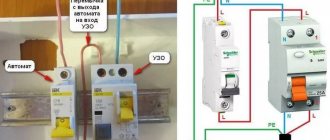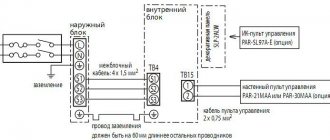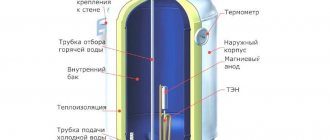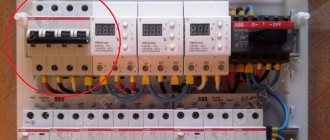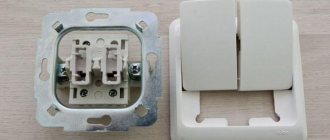Is it worth grounding a water heater in an apartment or in a house?
Liquid from the water supply is an excellent conductor, constantly in contact with the heater of a household appliance, regardless of the type (flow-through or storage). If the wires burn out or the housing of the heating element is destroyed, contact of water with electricity cannot be avoided. Contact with the metal body of the boiler or contact with a stream of water from a faulty device is inevitably accompanied by an electric shock. Due to the fact that it is impossible to quickly get out of the bath or shower, the impact of the current becomes fatal. One of the effective ways to reduce the negative impact (in conjunction with the installation of protective equipment) is to ground the water heater.
How to ground a water heater if there is no grounding?
The water entering the water supply system is a good conductor, and electric heating devices in apartments and private houses operate on electricity. Regardless of the type of electrical appliance (flow-through or storage), the liquid comes into contact with the heating element.
In another case, a potential difference may occur between two electrical appliances (you can often find the not entirely correct name “stray currents”) located in the same room. In this case, touching the devices at the same time also leads to a noticeable tingling sensation. Grounding in such cases serves to equalize the potentials of the circuits. In addition, the presence of “extra” potentials on devices accelerates their destruction.
Instructions
It is possible to ground a water heater without carrying out construction work to install the circuit in newly built apartment buildings (since 1998). In housing built according to old GOSTs, you will have to make changes to the wiring, install residual current devices (RCDs) or differential circuit breakers. In private houses, installation of a grounding loop is provided.
Grounding installation diagram: square and triangle
In addition to the protective effect in the event of an electric shock from an electric heater, the ground loop in a private home performs the function of maintaining the functionality of other electrical appliances in use. An important function is the potential equalization function (incorrectly in publications they are called “stray currents”), which will protect against injury when a person simultaneously touches two electrical appliances or in case of possible “current leaks” of a washing machine or dishwasher.
Correct connection of a boiler with a storage tank in the bathroom
The bodies of most storage boilers are made of sheet metal.
In places where water is used, this poses an additional electrical hazard. Electric shock from such devices can occur in two cases:
To reduce the danger, they try to install the boiler in a place where accidental contact when taking a shower is excluded (under the ceiling, at a sufficient distance from the bath).
Boilers are powered from separate circuit breakers.
How to make grounding
You can organize everything correctly with the help of our recommendations. Inspect the water heater and locate the ground terminals. All modern devices are equipped with them.
Buy an outlet with three holes and a moisture-resistant casing, especially if installing in a bathroom.
Some people use equipment without grounding. After heating the water, they disconnect the device from the network and begin operation. However, not everyone can remember this. In addition, the temperature settings are lost, and the storage device has to reheat the water, consuming electricity.
When choosing a boiler, experts recommend paying attention to the quality of the insulation of the heating element. In the future, this will help to avoid problems with violations and breakdowns.
What to do in a private house
In the private sector or at the dacha, you need to organize grounding yourself. You will need skills to use a welding machine. Also three metal pins (angles, pipes) 1.5 meters high and 15 mm in diameter.
READ How to connect a contactor coil 220
Select a site 1.5 meters from the house. No one should go here in the future.
All that remains is to connect the water heater, add water and start the test operation.
As you understand, grounding can be carried out both in Khrushchev and in the private sector. This is an important part of the operation of an electrical appliance. Watch the video to make it even easier:
Source
How to connect a shower water heater without grounding
If the water heater does not have a terminal for connecting the ground, then you can turn on the water only after turning off the power to the device.
To use the water heater without “pulling it out of the socket,” install residual current devices (RCDs) or an automatic (differential) device.
Without going into the details of the design of the devices, the principle of operation can be described as follows.
The RCD (difavtomat) is connected with one contact to the supply network, and on the other side the wires of the consumer device are connected.
The current from the phase through the heating element returns to RCD zero; it is the same in any part of the closed circuit. If there is a leak in the circuit - in our case through the human body to the ground - then the current at the point where the zero is connected will decrease compared to that leaving the phase. The RCD detects the difference and turns off both power wires. To guarantee protection against damage, the rated breaking current of the RCD must be 30 mA. The parameter is indicated in the RCD passport and on the body with the inscription “IΔn 30mA”.
How to connect a water heater to electricity - mistakes, choice of cable, socket, machines.
For a comfortable stay in the house, when you want to constantly use hot water, and not depend on the repair schedule of monopolists who can turn off this water for an unknown number of days, many people think about purchasing a boiler.
Most often, the choice falls towards a storage water heater. They come from different companies: Ariston, Drazice, Baxi, etc., shapes and designs - flat, cylindrical or elongated.
The installation of cold and hot water pipes may differ, but they are all connected to the 220V network in the same way.
Many people mistakenly believe that in order to connect the boiler, you just need to plug the plug into the socket and not worry about anything else. However, they forget that it is in the boiler that, in case of insulation failure, direct contact of electricity with a person can occur through water.
When renovating new apartments, the boiler is usually wired separately directly from the panel. If you want to connect the boiler to the old common wiring, which already has several sockets connected, be sure to make sure that it can withstand the power of the boiler.
In most cases, with a power of up to 3.5 kW, wiring must be done with a 3-core copper cable VVGnG-Ls, with a cross-section of at least 2.5 mm2.
The three-core cable is required to ensure a permanent connection to ground.
Choose a two-pole boiler connection machine. The rated current of the machine is 16A (sufficient for boiler power up to 3.5 kW).
For loads up to 2 kW, a circuit breaker with a rated current of 10 A is suitable.
If the boiler is connected from an outlet, then the outlet must have a degree of protection IP44. These are sockets for rooms with high humidity levels.
If it says that this boiler can be connected in two ways
then you will not lose the guarantee here.
In addition, if you need to dismantle the device from the wall, if there is a plug, you will not need to call an electrician to disconnect it from the power supply. Pull out the plug, take it off, rearrange it, do whatever you want.
Powerful boilers over 3.5 kW should only be connected directly through a circuit breaker; a socket connection is not allowed here.
The cable must be routed so that there are no intersections with water pipes and places where the heater will be mounted.
Leakage current for RCD – 10mA or 30mA.
Why 10mA is better and not more can be understood from this sign of the effect of current on the human body:
A significant disadvantage here is that at 10mA the protection may falsely trigger. Especially if your water heater has been hanging for more than a year and such condensation and moisture often form in the places where the terminals are connected.
How can I check if this is a false positive or if the heating element itself is faulty? To do this, use a multimeter.
Turn off the power supply or pull out the plug from the socket and disconnect the standard grounding from the titanium body.
Then remove the terminal clamps from the heating element itself, and using probes, measure the resistance between the boiler body and the heating element.
If the heating element is working properly, the readings on the multimeter screen should tend to infinity, that is, they should be something like this:
In case of breakdown and damage to the heater, they will either be zero, but most often they can be several hundred or even kiloohms. In the photo below this is exactly the option
Very often, in many of the latest boiler models, an RCD with a leakage current of 15 mA is already built into the cable for connecting to the outlet. In this case, it may not be necessary to install an additional leakage current protection device in the panel.
However, do not forget that such a built-in RCD will protect against leakage only if there is damage in the heater itself, but will not protect you in any way if there is a fault directly in the outlet or the supply wiring to it.
How to find these and other similar faults and what this can lead to can be found in the article “Electric shock in the bathroom. 5 reasons and what to do?”
Stages of grounding a water heater
Water heater grounding option.
The instructions for connecting the boiler to the network require mandatory grounding of the device body, which has a special stud with washers and a nut specifically for this purpose. If the device is not grounded, the service center will not provide a warranty on it.
Grounding to the water heater is carried out through a special contact in the plug and socket. Often, in order to make grounding, the water heater is equipped with a special terminal. In this case, grounding the device will not be difficult.
When self-grounding, very often the same mistake is made, which is to connect the socket and the boiler directly through a phase. Under no circumstances should this be done. Otherwise, the probability of emergency phase breakdown will increase. Most apartments built during the Soviet era use two-wire wiring, which is not intended for grounding. Due to the fact that modern household appliances, including a boiler, require a three-core cable, the old wiring must be replaced with new one.
Boiler connection diagram.
Important! The most common way to ground a water heater is to short the ground wire to any metal object, which, in turn, is connected directly to the ground. Most often, a plumbing or heating riser is used as such a metal object.
As for apartments in panel houses, in this case grounding can be done to embedded metal parts that are connected to the ground through a network of fittings. It is located in concrete slabs. The last option is considered the most favorable, since it does not contribute to the destruction of the water supply and heating risers
Most often, a plumbing or heating riser is used as such a metal object. As for apartments in panel houses, in this case grounding can be done to embedded metal parts that are connected to the ground through a network of fittings. It is located in concrete slabs. The last option is considered the most favorable, since it does not contribute to the destruction of the water supply and heating risers.
If it is impossible to replace the wiring, you can solve the problem in two ways:
- At a distance of 30 cm from the floor along the entire perimeter of the room, attach a metal strip to the wall. Near each socket, insert a bolt with a flat head into the rail so that the rail fits snugly against the wall. The ground wire is removed from the socket, after which it is exposed and wound around the bolt. At the very end, everything needs to be secured with a nut;
- From the sockets that need grounding, the cable is brought out externally and stretches to the baseboard. In a certain place, a chain of wires is connected for grounding, after which they are connected to the electrical panel.
Electrical diagram of a water heater.
Before grounding the water heating device, it is necessary to prepare the following tools and materials:
- steel wire;
- iron pins;
- bolts with washers and nuts;
- perforator;
- drill;
- hammer;
- inverter welding machine;
- spanners;
- sharpening machine.
How to connect a boiler to electricity without grounding: possible errors
Often, homeowners decide to install a boiler using video instructions, not because they do not have time, but because they save money. Let's assume that you already have experience in plumbing work, or some knowledge of electrical engineering. You will probably want to connect the boiler yourself, earning additional respect from your family. In this material we will consider in detail the algorithm for installing a water heater, taking into account the need for additional grounding and without it.
Basic connection methods
The boiler you choose may be equipped with a familiar Euro-plug, but in order to connect it correctly, you will have to install a socket of the appropriate type in the immediate vicinity of the water heater. Please note that such an outlet must be equipped with its own 16 amp circuit breaker.
Another option is possible: the boiler you purchased does not have both a plug and a cord. In this case, it will have to be directly connected to the electrical panel using a machine. With this connection, you can turn off the tank only using an automatic relay. It is recommended to install the switch closer to the tank, taking care of a moisture-proof housing for it. This will allow you to quickly turn off the power to the boiler in case of any unforeseen situation.
